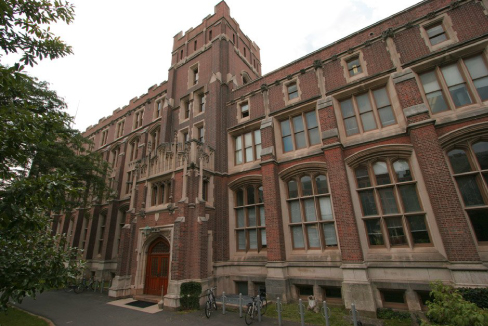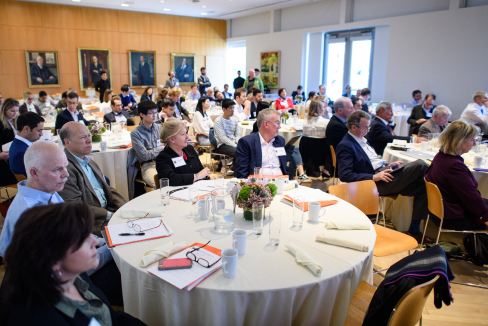With an Extension of Financial Support from bp, Princeton’s Carbon Mitigation Initiative Now to Run to 2020

In support of a long established partnership to find compelling and sustainable solutions to the carbon and climate change problem, bp has committed a further $10.5 million over five years to the Carbon Mitigation Initiative (CMI) at Princeton, which will fund the program from 2016 through 2020.
The program, which conducts research on climate science and low-carbon technology, began in 2000 and has been supported by bp since its inception.
Describing the goals of the long term research projects made possible through CMI, Stephen Pacala, Frederick D. Petrie Professor of Ecology and Evolutionary Biology at Princeton and CMI’s co-director, explained: “While the overall mission of CMI has been the same since it began, in recent years CMI climate science has increasingly focused on the emergent climate impacts that are driving governments to foster low-carbon economies.”
Co-director Robert Socolow, professor emeritus of mechanical engineering elaborated, “CMI’s and bp’s interests in climate mitigation technology have been aligned in addressing CO2 capture and storage (CCS). One group within CMI has been modeling carbon dioxide capture at coal and natural gas power plants and another group has been modedling the storage integrity of geological formations. At the same time, bp has worked on the In Salah CO2 project, an important international demonstration project pioneering the effective development of novel technologies for reducing greenhouse gas emissions to the atmosphere.”
Commenting on the importance of the relationship to bp, Felipe Bayon, senior vice president, bp America, and executive sponsor of the company’s Princeton partnership, commented: “CMI’s dynamic interdisciplinary program has added great value to bp in advancing our understanding of climate and energy science, technology, and policy. We look forward to continuing our involvement with Princeton researchers in order to maintain a vigilant corporate perspective on climate change.”
Bayon visited the Princeton campus on Friday, November 21, to announce the renewal. In a reception in Guyot Hall to mark the announcement, Princeton President Christopher L. Eisgruber thanked Bayon and bp for supporting the partnership with the University.

“This collaboration is remarkable not only because it exemplifies a very rare kind of partnership between a great university and a great company, but also because it does so in the context of addressing one of the most urgent — if not the single most urgent — problems that we as a world face right now,” Eisgruber said. “I look forward to welcoming our friends from bp back to campus in the future as we continue not only to celebrate this relationship but also to witness the remarkable science and solutions that come out of it.”
About CMI:
- The CMI program currently includes 20 lead faculty principal investigators and over 70 research staff and students at Princeton. Its three components address Science, Technology, and Integration/Outreach.
- CMI Science has long focused on how terrestrial vegetation and the oceans soak up carbon and thereby determine the fraction of the carbon dioxide emitted into the atmosphere that actually stays there (the fraction is about one-half). CMI science increasingly features close collaboration with Princeton’s neighbor, the Geophysical Fluid Dynamics Laboratory of the U.S. Department of Commerce. A recent and growing component of CMI addresses climate variability and departures from the historical frequency of extreme events, such as heat waves, droughts and hurricanes.
- CMI Technology is adding new elements to low-carbon energy research that increase the attention on transport. A comprehensive comparison of biochemical and thermochemical conversion of biomass to vehicle fuels is one element, and a new program on advanced batteries is another. Modeling of the migration of carbon dioxide placed in geological formations continues, with direct ties to the related regulatory regimes throughout the world that are gradually taking shape.
- CMI Integration and Outreach continues to introduce new conceptual frameworks that are useful for climate change policy. A high bar was set with the work on “stabilization wedges” in 2004 and subsequent outreach efforts. An emerging area is the interpretation for broad audiences of findings about extreme events, which implements the findings of the CMI Science research. Two new efforts address cost estimation for large first-of-a-kind energy projects and the penetration of intermittent renewables (solar and wind) into the electric grid. Other work seeks to deepen the concept of “carbon budgets” by promoting systematic thinking about humankind’s collective future for various time frames.
- To date, CMI participants have published over 700 peer-reviewed articles related to their CMI work. The 2004 Science article by Pacala and Socolow, “Stabilization Wedges: Solving the Climate Problem for the Next 50 Years with Current Technologies,” has been cited more than 2,000 times in peer-reviewed science and policy literature.



